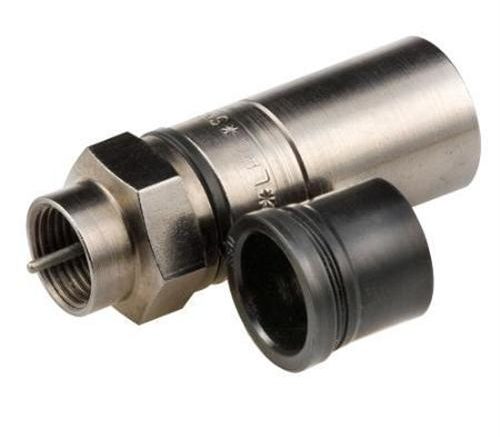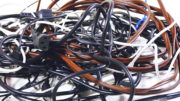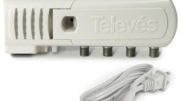Quick answer: probably not.
RG11 cable is a special kind of coaxial cable. It’s built for longer runs, and in general you’ll find that you can run 50-100 feet longer with RG11 and still keep an acceptable signal level. However, it’s not perfect for every use. Let’s take a look at RG11 cable and why it’s great for long runs but not for short ones.
Built to be tough
Everything about RG11 cable is built to be stronger. The inner dielectric (the white part) is almost twice as thick as the same part in RG6 cable. All told, a typical RG11 cable is about 33% thicker than a typical RG6 cable, although every manufacturer is different. Often times, RG11 cables use heavy-duty connectors, thicker jackets on the outside, and higher-quality materials. RG11 cable is for when you want to get serious
It’s about loss over distance
The whole goal of RG11 cable is to give you a longer cable run. At the typical frequencies where satellite signals live, a 250 foot run of RG6 will have 6dB loss, or about 200% worse performance. That can be the difference between getting a signal and not getting a signal. Sure you can put in an amplifier but what if there’s no place for an amplifier between one end of the cable and the other? RG11 cable is here to help. In this same example, you can run 300 feet with RG11, and have the same loss characteristics as 250 feet of RG6.
So why not use RG11 all the time?
If RG11 is this miraculous cable that can solve all these distance problems, you would think you would use it everywhere. Unfortunately, the power of RG11 comes with some real limitations.
It’s expensive.
RG11 cable can be double the price of RG6 cable, depending on the choices you make. That number can really make a dent in your budget if you’re doing a very large project.
It’s bulky.
RG11 cable is really stiff and bulky, because it’s so much thicker than regular RG6 cable. Think about how your big down jacket makes it harder for you to maneuver around, and it’s the same thing. RG11 cable doesn’t like anything but the gentlest of bends, and the connectors can be twice as long as regular RG6 compression connectors. They’re thicker too. This means that it may simply be impossible to get RG11 connections straight to a TV or receiver.
Then there are “reflections.”
This is the hardest part to explain, but I’ll try.
Think of how, when you pour water into a funnel it splashes back up. Pour too fast and you’ll lose more water from the splash than actually goes down the hole!
That same effect comes into play with cables, and we call it “reflection.” As a signal enters a connector, some of it “splashes back” onto the cable. It’s normally not a big deal and the part of the cable that is affected by reflections is usually about a foot or so. (That’s the reason commercial installers like cable lengths to be two feet at the minimum.) However, the bulky RG11 connector and the big thick cable combine to allow reflections to travel up to 50 feet back down the cable. Keep in mind that there’s a reflection on both sides and that’s why it’s a bad idea to have RG11 cables that are shorter than 100 feet.
When reflection happens, the overall quality of the signal suffers, just like when you get water drops on a window. Often times the signal is strong enough to overcome this, but the whole point of putting in RG11 cable in the first place is to make things better, not worse.
You may not see a benefit in short runs
In a 100 foot run, you will net about 3dB more signal using RG11 than you would using RG6. However, when you use a barrel connector and a short RG6 jumper, you will lose roughly 2dB due to insertion loss. This means that the whole net gain from all that work and expense will be 1dB. That’s hardly worth the effort in most cases. I use this calculator to check losses at different frequencies and it helps me decide if RG11 is the best option.
You can mix coaxial cable types
It’s very common for RG11 to be used for long runs and RG6 to be used for shorter runs. Typically you would switch cable types at an intermediate closet where the RG11 cable will go into an amplifier and RG6 cable will come out. Generally you would not want to splice the two types together with a barrel if you could avoid it.
Folks, every tool in the A/V installer’s kit has a purpose. The purpose of RG11 cable is to make long runs easier. The purpose of RG6 cable is to make short runs easier. Use the two for what they’re intended for. Simple as that.
If you’re looking for RG11 cable or any other coaxial cable, check out the great selection at Solid Signal. If you have questions, call us at 888-233-7563 or fill out the form below.





